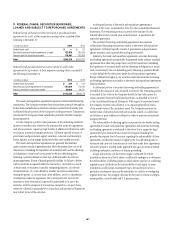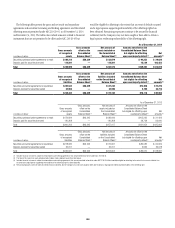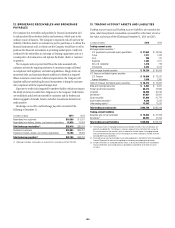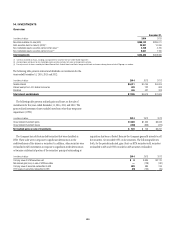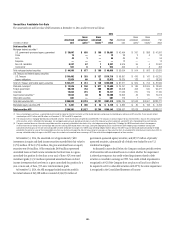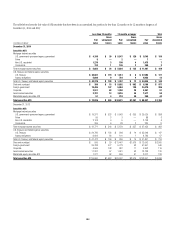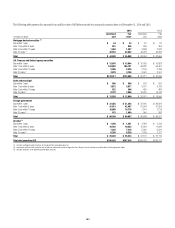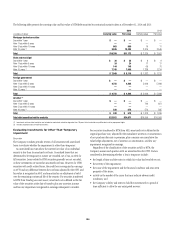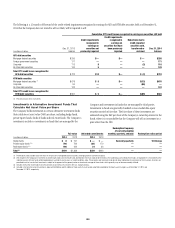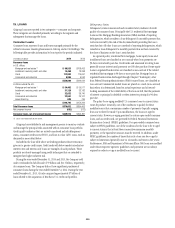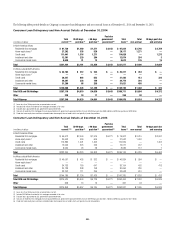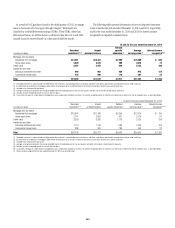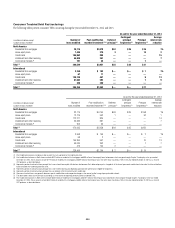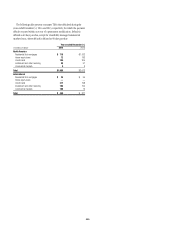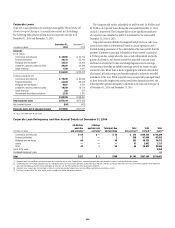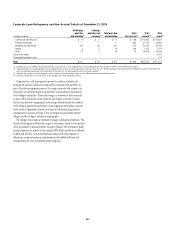Citibank 2014 Annual Report Download - page 214
Download and view the complete annual report
Please find page 214 of the 2014 Citibank annual report below. You can navigate through the pages in the report by either clicking on the pages listed below, or by using the keyword search tool below to find specific information within the annual report.197
The Company’s review for impairment generally entails:
• identification and evaluation of impaired investments;
• analysis of individual investments that have fair values less than
amortized cost, including consideration of the length of time the
investment has been in an unrealized loss position and the expected
recovery period;
• consideration of evidential matter, including an evaluation of factors
or triggers that could cause individual investments to qualify as having
other-than-temporary impairment and those that would not support
other-than-temporary impairment; and
• documentation of the results of these analyses, as required under
business policies.
Debt
The entire difference between amortized cost basis and fair value is
recognized in earnings as OTTI for impaired debt securities that the
Company has an intent to sell or for which the Company believes it will
more-likely-than-not be required to sell prior to recovery of the amortized
cost basis. However, for those securities that the Company does not intend to
sell and is not likely to be required to sell, only the credit-related impairment
is recognized in earnings and any non-credit-related impairment is recorded
in AOCI.
For debt securities, credit impairment exists where management does not
expect to receive contractual principal and interest cash flows sufficient to
recover the entire amortized cost basis of a security.
Equity
For equity securities, management considers the various factors described
above, including its intent and ability to hold the equity security for a period
of time sufficient for recovery to cost or whether it is more-likely-than-not
that the Company will be required to sell the security prior to recovery of
its cost basis. Where management lacks that intent or ability, the security’s
decline in fair value is deemed to be other-than-temporary and is recorded
in earnings. AFS equity securities deemed to be other-than-temporarily
impaired are written down to fair value, with the full difference between fair
value and cost recognized in earnings.
Management assesses equity method investments that have fair values
that are less than their respective carrying values for OTTI. Fair value is
measured as price multiplied by quantity if the investee has publicly listed
securities. If the investee is not publicly listed, other methods are used (see
Note 25 to the Consolidated Financial Statements).
For impaired equity method investments that Citi plans to sell prior to
recovery of value or would likely be required to sell, with no expectation that
the fair value will recover prior to the expected sale date, the full impairment
is recognized in earnings as OTTI regardless of severity and duration. The
measurement of the OTTI does not include partial projected recoveries
subsequent to the balance sheet date.
For impaired equity method investments that management does not plan
to sell and is not likely to be required to sell prior to recovery of value, the
evaluation of whether an impairment is other-than-temporary is based on
(i) whether and when an equity method investment will recover in value and
(ii) whether the investor has the intent and ability to hold that investment for
a period of time sufficient to recover the value. The determination of whether
the impairment is considered other-than-temporary considers the following
indicators, regardless of the time and extent of impairment:
• the cause of the impairment and the financial condition and near-term
prospects of the issuer, including any specific events that may influence
the operations of the issuer;
• the intent and ability to hold the investment for a period of time sufficient
to allow for any anticipated recovery in market value; and
• the length of time and extent to which fair value has been less than the
carrying value.
The sections below describe the Company’s process for identifying
credit-related impairments for security types that have the most significant
unrealized losses as of December 31, 2014.
Akbank
As of December 31, 2014, Citi’s remaining 9.9% stake in Akbank T.A.S., an
equity investment in Turkey (Akbank), is recorded within marketable equity
securities available-for-sale. The revaluation of the Turkish lira was hedged,
so the change in the value of the currency related to Akbank investment did
not have a significant impact on earnings during the year.
Mortgage-backed securities
For U.S. mortgage-backed securities (and in particular for Alt-A and other
mortgage-backed securities that have significant unrealized losses as a
percentage of amortized cost), credit impairment is assessed using a cash
flow model that estimates the principal and interest cash flows on the
underlying mortgages using the security-specific collateral and transaction
structure. The model distributes the estimated cash flows to the various
tranches of securities, considering the transaction structure and any
subordination and credit enhancements that exist in that structure. The cash
flow model incorporates actual cash flows on the mortgage-backed securities
through the current period and then estimates the remaining cash flows
using a number of assumptions, including default rates, prepayment rates,
recovery rates (on foreclosed properties) and loss severity rates (on non-
agency mortgage-backed securities).
Management develops specific assumptions using market data, internal
estimates and estimates published by rating agencies and other third-party
sources. Default rates are projected by considering current underlying
mortgage loan performance, generally assuming the default of (i) 10%
of current loans, (ii) 25% of 30-59 day delinquent loans, (iii) 70% of
60-90 day delinquent loans and (iv) 100% of 91+ day delinquent loans.
These estimates are extrapolated along a default timing curve to estimate the


